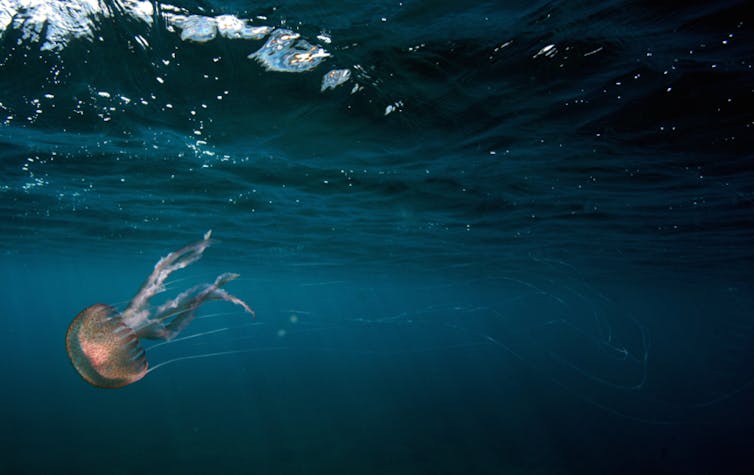For most marine biologists, myself included, it wasn’t until 2005 that it dawned on us that a third of all human-caused carbon dioxide emissions are dissolving into and acidifying the sea.
By driving down seawater pH (and increasing acidity), these emissions are increasingly bad news for marine organisms that build their protective shells and skeletons out of calcium carbonate. When seawater becomes too acidic, calcium carbonate structures begin to corrode, dissolving baby oysters, coral skeletons, and many other creatures.
And while much has been written about the species that will lose out, a lot less has been said about the potential “winners” of ocean warming and acidification.
In a recently published paper, we present evidence that the slimy, jelly-like creatures of the oceans are far more tolerant of rising marine carbon dioxide levels. It is these creatures that are likely to proliferate in a warmer and increasingly acidic ocean.
Unfortunately for life in the sea, many of these lucky species are already considered a nuisance in marine ecosystems.
What volcanic vents can tell us about ocean acidification
There are places already on Earth that show us what the future might look like. The waters surrounding some coastal volcanoes are high in CO₂ and low in aragonite (a form of calcium carbonate).
Volcanic activity causes CO₂ to bubble up (or “seep”) from the sea floor, acidifying large areas for hundreds of years. The tricky bit is finding carbon dioxide seeps without other minerals which confuse the story. But it can be done, and researchers have begun to study a number of these naturally acidified areas to understand which organisms thrive, and which are most vulnerable to ocean acidification.
We have found that chronic exposure to increases in CO₂ alters food webs and causes marine biodiversity loss around underwater volcanic seeps in the Mediterranean, the Sea of Cortez, and off Papua New Guinea. Key groups, like corals and hard, skeleton-building algae, are consistently compromised and fish reproduction is disrupted.
Meanwhile, higher CO₂ levels stimulate the growth of certain single-celled algae, seaweeds, and seagrasses. If temperatures remain low enough then the symbiotic algae of corals and anemones do well, as do numerous invasive species of animals and algae.
Some organisms have tissues that protect their shells and skeletons – including some corals in the tropics, and mussels in temperate seas – meaning they can tolerate acidified seawater. Yet these animals, despite being tough, can still experience adverse effects on reproduction, behaviour, respiration, and growth when carbon dioxide levels ramp up.
The fossil record serves as a warning. Shells found after high-CO₂ mass extinction events are much smaller than their ancestors — a phenomenon known as the Lilliput effect. Work at volcanic seeps has shown that smaller animals are better able to cope with the stress of ocean acidification.
And while the carbon boost provided by ocean acidification can drive up phytoplankton productivity, it can also harm tropical coral reefs. A fall in carbonate levels causes coral skeletons to dissolve, and increased CO₂ levels stimulates the growth of seaweeds that smother the reefs.
Nuisance species will thrive
It is now clear that tropical coral reefs face a host of interconnected problems (bleaching, corrosion, disease, spreading seaweed, invasive species) that are all exacerbated by rising CO₂ levels.
Invasive species of algae and jellyfish thrive at the levels of carbon dioxide that are predicted to occur this decade. Our review of laboratory experiments reveals stand-out cases such as so called “Killer algae” (Caulerpa taxifolia). This species, which benefits from higher CO₂, is spreading world-wide and is so toxic that native herbivores die of starvation rather than eat it.
It turns out that loads of notorious nuisance species – such as Japanese kelp (Undaria pinnatifida) and stinging jellyfish (Pelagia noctiluca) — are resilient to rising CO₂ levels.

Global warming and changes in seawater chemistry may help the spread of hundreds of these damaging marine organisms.
Tackling the issue
Ocean acidification research is the new kid on the block amongst planetary environmental issues. But as evidence rolls in from across the globe it is clear that many organisms are likely to be affected, resulting in both winners and losers.
Both the decline of vulnerable species and the spread of harmful marine organisms should be factored into calculations of the risks of climate change and ocean acidification.
If we want to curb the spread of harmful marine life, like toxic algae and stinging jellyfish, then reducing CO₂ emissions is definitely part of the solution. This is why there is a growing awareness of the central role of ocean issues in climate negotiations at COP21 in Paris and beyond.
But local solutions to this global issue can also have a range of benefits. The International Union for the Conservation of Nature Blue Carbon initiative, for example, recognises the ability of coastal vegetation (e.g. saltmarshes and seagrasses) to prevent acid water run-off, and capture and store carbon - raising the pH of coastal waters. Other solutions include seaweed farming and the gradual restoration of mangroves in areas that have been converted to shrimp farms.
To properly address the crisis of our warming and acidifying oceans, we must attack this issue from every angle. It’s time we began thinking about the ways we can more sustainably work with, and for, our oceans in order to preserve life on Earth.

